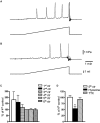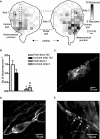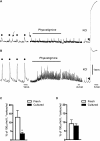Spontaneous release of acetylcholine from autonomic nerves in the bladder
- PMID: 19371347
- PMCID: PMC2707973
- DOI: 10.1111/j.1476-5381.2009.00166.x
Spontaneous release of acetylcholine from autonomic nerves in the bladder
Abstract
Background and purpose: Bladder contractility is regulated by intrinsic myogenic mechanisms interacting with autonomic nerves. In this study, we have investigated the physiological role of spontaneous release of acetylcholine in guinea pig and rat bladders.
Experimental approach: Conventional isotonic or pressure transducers were used to record contractile activity of guinea pig and rat bladders.
Key results: Hyoscine (3 micromol x L(-1)), but not tetrodotoxin (TTX, 1 micromol x L(-1)), reduced basal tension, distension-evoked contractile activity and physostigmine (1 micromol x L(-1))-evoked contractions of the whole guinea pig bladder and muscle strips in vitro. omega-Conotoxin GVIA (0.3 micromol x L(-1)) did not affect physostigmine-induced contractions when given either alone or in combination with omega-agatoxin IVA (0.1 micromol x L(-1)) and SNX 482 (0.3 micromol x L(-1)). After 5 days in organotypic culture, when extrinsic nerves had significantly degenerated, the ability of physostigmine to induce contractions was reduced in the dorso-medial strips, but not in lateral strips (which have around 15 times more intramural neurones). Most muscle strips from adult rats lacked intramural neurones. After 5 days in culture, physostigmine-induced or electrical field stimulation-induced contractions of the rat bladder strips were greatly reduced. In anaesthetized rats, topical application of physostigmine (5-500 nmol) on the bladder produced a TTX-resistant tonic contraction that was abolished by atropine (4.4 micromol x kg(-1) i.v.).
Conclusions and implications: The data indicate that there is spontaneous TTX-resistant release of acetylcholine from autonomic cholinergic extrinsic and intrinsic nerves, which significantly affects bladder contractility. This release is resistant to blockade of N, P/Q and R type Ca(2+) channels.
Figures








Comment in
-
Words of wisdom. Re: Spontaneous release of acetylcholine from autonomic nerves in the bladder.Eur Urol. 2010 Jan;57(1):171-2. doi: 10.1016/j.eururo.2009.10.007. Eur Urol. 2010. PMID: 20178729 No abstract available.
Similar articles
-
Effects of omega-conotoxin GVIA on autonomic neuroeffector transmission in various tissues.Br J Pharmacol. 1990 Oct;101(2):437-47. doi: 10.1111/j.1476-5381.1990.tb12727.x. Br J Pharmacol. 1990. PMID: 2175236 Free PMC article.
-
Omega conotoxin and prejunctional modulation of the biphasic response of the rat isolated urinary bladder to single pulse electrical field stimulation.J Auton Pharmacol. 1991 Oct;11(5):295-304. doi: 10.1111/j.1474-8673.1991.tb00253.x. J Auton Pharmacol. 1991. PMID: 1721069
-
Constitutively active PKA regulates neuronal acetylcholine release and contractility of guinea pig urinary bladder smooth muscle.Am J Physiol Renal Physiol. 2016 Jun 1;310(11):F1377-84. doi: 10.1152/ajprenal.00026.2016. Epub 2016 Mar 30. Am J Physiol Renal Physiol. 2016. PMID: 27029424 Free PMC article.
-
Effects of omega-conotoxin on adrenergic, cholinergic and NANC neurotransmission in the rabbit urethra and detrusor.Br J Pharmacol. 1993 Dec;110(4):1285-90. doi: 10.1111/j.1476-5381.1993.tb13957.x. Br J Pharmacol. 1993. PMID: 8306066 Free PMC article.
-
Effect of omega-conotoxin GVIA on tetrodotoxin-insensitive acetylcholine release by nicotine in guinea-pig bladder.Gen Pharmacol. 1995 Sep;26(5):1077-81. doi: 10.1016/0306-3623(94)00266-p. Gen Pharmacol. 1995. PMID: 7557254
Cited by
-
Emerging Families of Ion Channels Involved in Urinary Bladder Nociception.Pharmaceuticals (Basel). 2010 Jul 19;3(7):2248-2267. doi: 10.3390/ph3072248. Pharmaceuticals (Basel). 2010. PMID: 27713353 Free PMC article. Review.
-
ATP transients accompany spontaneous contractions in isolated guinea-pig detrusor smooth muscle.Exp Physiol. 2019 Nov;104(11):1717-1725. doi: 10.1113/EP087960. Epub 2019 Oct 14. Exp Physiol. 2019. PMID: 31464344 Free PMC article.
-
The effect of indomethacin on the muscarinic induced contractions in the isolated normal guinea pig urinary bladder.BMC Urol. 2013 Feb 7;13:8. doi: 10.1186/1471-2490-13-8. BMC Urol. 2013. PMID: 23388044 Free PMC article.
-
Specific inhibition of acetylcholinesterase as an approach to decrease muscarinic side effects during myasthenia gravis treatment.Sci Rep. 2018 Jan 10;8(1):304. doi: 10.1038/s41598-017-18307-9. Sci Rep. 2018. PMID: 29321572 Free PMC article.
-
Altered detrusor contractility and voiding patterns in mice lacking the mechanosensitive TREK-1 channel.BMC Urol. 2019 May 21;19(1):40. doi: 10.1186/s12894-019-0475-3. BMC Urol. 2019. PMID: 31113422 Free PMC article.
References
-
- Alian M, Gabella G. Decrease and disappearance of intramural neurons in the rat bladder during post-natal development. Neurosci Lett. 1996;218:103–106. - PubMed
-
- Andersson KE. Antimuscarinics for treatment of overactive bladder. Lancet Neurol. 2004;3:46–53. - PubMed
-
- Birder LA. More than just a barrier: urothelium as a drug target for urinary bladder pain. Am J Physiol Renal Physiol. 2005;289:F489–495. - PubMed
-
- Brading AF. A myogenic basis for the overactive bladder. Urology. 1997;50:57–67. - PubMed
Publication types
MeSH terms
Substances
LinkOut - more resources
Full Text Sources
Miscellaneous

